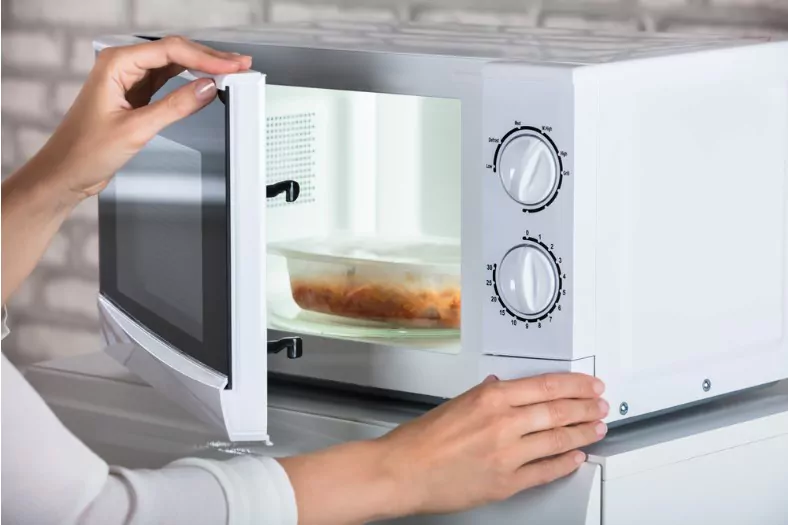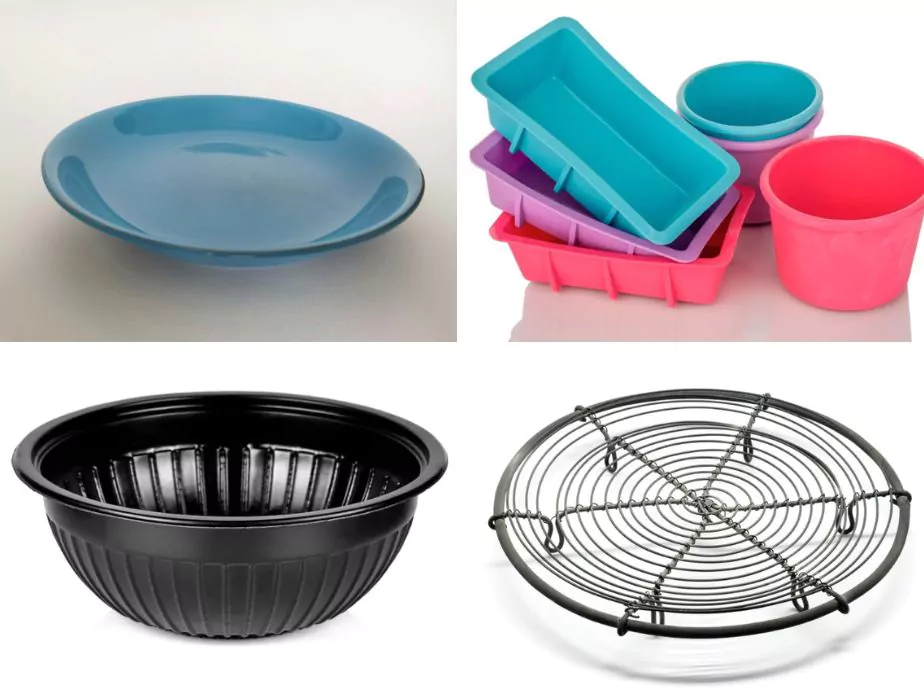How To Maintain Your Microwave Oven at Home?

In today’s fast-paced world, the microwave oven has emerged as a kitchen superhero, coming to the rescue for quick meals and last-minute reheats. But like all superheroes, it too needs a little care and attention to ensure its longevity. If you’ve ever wondered how to maintain your microwave oven to keep it running efficiently for years, you’re in the right place. This guide will delve deep into easy-to-follow steps and expert advice, ensuring that your trusty appliance stays in tip-top shape. Read on to embark on a journey of microwave maintenance mastery!
- Understanding the Science Behind Microwaves
- Benefits of Using Microwave Ovens
- Maintaining Your Microwave Oven
- What type of pans do you need for a convection microwave oven?
- Benefits of Using a Microwave Oven
- Safety Tips for Using Microwave Ovens
- What are the most common uses of microwave ovens?
- Wrapping Up
1 Understanding the Science Behind Microwaves
Microwave ovens heat food using electromagnetic radiation, specifically microwave energy. Unlike other heating methods, microwaves target water molecules, making them oscillate. This rapid movement generates heat, which then cooks food from the inside out. It’s why a microwave can heat food so quickly, sometimes faster than boiling water on a stovetop.
But how do countertop microwave ovens ensure that the heat is evenly spread? The oven cavity is designed to reflect microwaves throughout, ensuring that food items receive consistent heating. And if you’ve ever wondered why metal utensils and aluminum foil can catch fire in a microwave, it’s because microwaves bounce off metal surfaces, creating electrical sparks.
2 Benefits of Using Microwave Ovens
- Energy Efficient: Microwaves typically use less energy than traditional ovens. They cook food faster, using more energy per minute but requiring less overall cooking time.
- Nutritional Value: Studies have shown that microwave cooking can retain the nutrient content of certain foods better than conventional cooking methods.
- Convenience: The ability to cook food or reheat food quickly is unmatched. From reheating your morning coffee to defrosting chicken for dinner, it’s a time-saver.
- Variety in Cooking: With the advent of convection microwave ovens, you can now bake, roast, and grill, making baked goods and roast garlic a possibility.
3 Maintaining Your Microwave Oven
Maintaining a microwave, whether it’s a convection microwave or a standard model, ensures longevity, energy efficiency, and optimal cooking results.
- Regular Cleaning: Food splatters can absorb microwave energy, leading to uneven cooking. Regularly clean the inner surfaces with a solution of lemon juice and water. Citrus fruits, like lemon, can break down grime, leaving your oven smelling fresh. Avoid using abrasive kitchen sponges, which can scratch the surfaces.
- Checking the Door Seal: Prevent leakage of microwave radiation by ensuring that the door seals correctly. A damaged seal can lead to electromagnetic fields exceeding the standard one milliwatt per square centimetre. If you suspect a faulty seal, consult the manufacturer’s instructions or seek professional advice.
- Safe Containers: Use microwave-safe containers. Plastic containers not labeled as “microwave safe” can release harmful chemicals when heated. On the other hand, glass, ceramic, and certain plastics are generally safe. Avoid metal box-like containers and aluminum foil, as these can spark and potentially cause a fire.
- Monitor Cooking Time: Overcooking or reheating food for too long can dry out the food, reduce its nutritional value, and sometimes even damage the oven. Adhere to recommended cooking times and observe how different food items behave.
- Rotate and Stir: Ensure even heating by stirring liquid items and turning larger food items. This method prevents hot spots, like boiling temperature in one section while the outer layers remain cold.
- Avoid Overloading: While microwaves can cook food rapidly, overloading can lead to uneven cooking results. Plus, it requires more energy, counteracting the energy-efficient benefits of microwaves.
Safety Precautions
- Microwave Safe Materials: As previously mentioned, never use metal utensils, aluminum foil, or any non-microwave safe materials.
- Supervise Cooking: Microwaves can heat irregularly, especially if the food has uneven water content. It’s why hot butter might explode or why certain foods, like citrus fruits, can erupt.
- Electromagnetic Interference: While modern microwaves are designed to prevent leakage, it’s always a good idea to stand a short distance away during operation to minimize exposure to electromagnetic radiation.
- Children: Always supervise children when using the microwave. Ensure they understand the basics of microwave safety.
- Radiological Health: Modern microwaves adhere to safety standards set by health organizations, ensuring that the levels of microwave radiation emitted are safe. Regular maintenance can ensure these standards remain intact.
Choosing the Right Microwave
Whether opting for convection microwave ovens or simpler models, understanding your needs is essential. Do you want to bake or just reheat food? How much space do you have? Do you want energy-efficient options or those with more power? Answering these questions will guide your purchase.
4 What type of pans do you need for a convection microwave oven?

Convection microwave ovens are versatile appliances that combine the capabilities of a standard microwave with those of a convection oven. As a result, they can heat, bake, roast, and brown food. When it comes to using pans and containers in a convection microwave oven, it’s essential to choose the right type for optimal and safe cooking. Here’s a guide to the types of pans you can use:
- Microwave-Safe Glass or Ceramic: Both in microwave and convection mode, containers made of microwave-safe glass (like Pyrex or Corning ware) or ceramic are suitable. They don’t react to microwaves or the heat of a convection oven and are thus a safe choice for most cooking tasks.
- Silicone Bakeware: Silicone bakeware is flexible, non-stick, and can withstand both microwave and convection oven temperatures. They’re great for baking muffins, cakes, and more.
- Metal Pans: While you should never use metal pans in standard microwave mode because they can cause sparks and potentially damage the microwave, you CAN use them in the convection mode of a convection microwave oven. This means that you can use regular baking pans, cookie sheets, and metal racks when you’re using your appliance as a convection oven.
- Browning Dishes: These are specially designed for microwave use to help brown the food. They can become very hot and can help in crisping the base of foods like pizzas or pies.
- Microwave-Safe Plastic: If the plastic container is labeled as microwave-safe, it’s typically safe for use in the microwave mode. However, many plastic containers may not withstand the higher temperatures of the convection mode. Always check the manufacturer’s guidelines.
- Oven-Safe Metal Racks: Some convection microwave ovens come with metal racks. These racks elevate the food, allowing it to cook and brown more evenly. Ensure the rack is designed for use in your specific microwave model.
- Combi Cooking: When using the combination mode, which uses both microwave and convection cooking simultaneously, it’s essential to use containers that can safely handle both types of heating. Typically, microwave-safe glass or ceramic dishes are the best choices.
Utensils you should avoid while cooking in microwave
- Regular Plastic Containers: Many standard plastic containers, like take-out containers or butter tubs, can warp, melt, or release harmful chemicals when exposed to the high temperatures of a convection oven or microwave.
- Metallic Trims or Paint: Even in convection mode, avoid using dishes with metallic trims or paint as they can spark or get damaged.
- Aluminum Foil: While it can be used cautiously in convection mode, there’s a risk of fire or damaging the oven if it’s too close to the oven walls or if used in microwave mode.
General Tips to keep in mind while cooking in a microwave
Always use oven mitts or pot holders when removing pans or dishes from the convection microwave oven, as they can become very hot.
Monitor your food, especially the first time you use a specific pan or dish, to ensure it cooks evenly and that there’s no risk of sparking or damage.
Even if a dish is labeled as microwave or oven safe, always check the manufacturer’s guidelines for any specific precautions or temperature limits.
5 Benefits of Using a Microwave Oven
Microwave ovens have become a staple in modern kitchens around the world and for good reason. They offer a multitude of benefits, making cooking, reheating, and food preparation simpler and faster. Here are some notable advantages of using a microwave oven:
- Speed: One of the primary benefits of a microwave oven is the speed at which it can cook food. Microwave ovens heat food much more quickly than conventional ovens or stovetops.
- Energy Efficiency: Microwaves consume less energy than traditional electric or gas stoves. This can translate to reduced energy bills over time.
- Uniform Heating: Thanks to the way microwaves cook food, heat is often distributed more evenly. This ensures that the food is cooked uniformly, preventing cold spots.
- Simplicity and Convenience: Whether you’re heating leftovers, making popcorn, or thawing frozen food, the process is straightforward with a microwave. The user-friendly settings and functions make it accessible to everyone.
- Less Cooking Wear: Microwave cooking often retains more vitamins and minerals in food because it cooks quickly and without a lot of water.
- Safety: There’s no open flame or hot cooking surface with a microwave oven. This reduces the risk of burns and other kitchen accidents.
- Reduced Cleaning: Microwave cooking often requires fewer pots and pans. Plus, many microwaves come with an easy-to-clean interior surface. When using microwave-safe covers or lids, splatters, and spills can be minimized.
- Compact Size: Microwave ovens are ideal for small kitchens or living spaces without a full-sized kitchen. They take up minimal counter space.
- Versatility: Modern microwaves come with various features like convection cooking, grilling, and steaming. These features combine the benefits of conventional ovens with microwave speed.
- Cost-effective: When compared to traditional ovens or ranges, microwaves are typically more affordable.
- Frozen Food Thawing: Microwaves offer a quick and efficient method to defrost frozen foods, which is especially handy if you forgot to take something out of the freezer in advance.
- Reduces Heat in the Kitchen: Unlike traditional stovetops or ovens that can heat up your kitchen, especially during summer, microwaves keep the kitchen cooler.
- Integrated Timers: The built-in timers in microwaves allow for precision cooking, preventing overcooking or undercooking.
- Consistent Results: Once you know the correct settings and time for your favorite recipes, microwaves can produce consistent results every time.
- Preservation of Nutrients: Because microwave cooking often requires shorter cooking times, it can help preserve the nutrient content of foods better than some prolonged cooking methods.
6 Safety Tips for Using Microwave Ovens
Read the User Manual: Before using your microwave oven for the first time, take a moment to read the manufacturer’s instructions. This will provide information specific to your model and ensure you understand its features and functions.
Avoid Metal: Never place metal objects, such as aluminum foil, utensils, or metal-trimmed containers, in the microwave. Metal can cause sparks, which might lead to a fire.
Use Microwave-Safe Containers: Only use containers labeled as “microwave safe.” Some plastics can melt or release harmful chemicals when heated. Glass, ceramic, and certain plastic containers are generally safe for microwave use.
Vent Containers: When heating food, ensure containers are vented to allow steam to escape. This can be done by leaving a corner of a covering loose or using a vented microwave-safe lid.
Avoid Superheating: Be cautious when heating liquids, especially water. It can “superheat” and suddenly boil over when disturbed, leading to burns. To avoid this, always place a non-metallic object, like a wooden stir stick or sugar stick, in the cup or bowl.
Stir Food Occasionally: To ensure even cooking and prevent hot spots, stir or rotate your food midway through the cooking time.
Test Temperature: Before eating, especially when heating for babies or toddlers, test the food’s temperature. Microwaved food can have uneven temperatures, with some areas much hotter than others.
Be Cautious with Eggs: Never microwave eggs in their shells or whole hard-boiled eggs, as they can explode.
Stand By: Stay close to the microwave while it’s operating. This allows you to react quickly if you see or smell something unusual.
Check Door Seal: Ensure that the microwave door seal is clean and free from debris. A proper seal prevents microwave radiation from leaking.
Child Safety: Always supervise children when they use the microwave. Consider using the child-lock feature if your microwave has one.
Use Oven Mitts: Some containers can get very hot in the microwave. Always use oven mitts or a thick cloth when removing items.
Don’t Dry Clothes: It might sound unusual, but some people have tried drying clothes or other non-food items in microwaves. This can be a fire hazard.
Regularly Clean the Microwave: Built-up food residue can lead to fires or decreased efficiency. Regular cleaning helps prevent this. A simple mix of water and lemon juice heated for a few minutes can help soften food splatters for easier cleaning.
Check for Damage: If your microwave shows signs of damage, such as a broken door latch or a malfunctioning display, stop using it and have it inspected or replaced.
Avoid Operating Empty: Running a microwave without anything inside can damage the microwave’s components.
Be Aware of Package Instructions: Many microwaveable packaged foods come with specific instructions, including standing time after heating. This allows heat to disperse evenly.
Let Food Stand: After cooking in the microwave, let the food stand for a minute or two. This allows the heat to spread and the food to finish cooking.
7 What are the most common uses of microwave ovens?
Microwave ovens have become an essential kitchen appliance in many households around the world due to their convenience and speed. Here are some of the most common uses of microwave ovens:
Reheating Food: Perhaps the most common use of microwave ovens is to reheat leftovers. Whether it’s last night’s dinner or takeout, microwaves can warm food in just minutes.
- Cooking Frozen Food: Many frozen foods, from TV dinners to vegetables, come with microwave instructions for quick and easy preparation.
- Defrosting: Microwaves often have a defrost setting that allows users to thaw frozen foods more quickly than leaving them out or using cold water.
- Making Popcorn: Microwavable popcorn is a popular snack, and many microwaves even have a designated “popcorn” button.
- Steaming Vegetables: With a little water and a microwave-safe container, you can quickly steam vegetables to perfection.
- Softening Butter: Need softened butter for a recipe but forgot to take it out of the fridge? A few seconds in the microwave can do the trick.
- Melting Chocolate: Whether for baking or making desserts, microwaves can melt the chocolate evenly without the need for a double boiler.
- Heating Beverages: From reheating a cold cup of coffee to warming up milk, microwaves can quickly get liquids to the desired temperature.
- Cooking Eggs: While it requires a bit of care to avoid explosions, you can poach, scramble, or even make an omelette in a microwave.
- Cooking Bacon: Laid out on a microwave-safe dish with a way to drain the fat, bacon can be crisped in a microwave.
- Baking: With convection microwave ovens, you can bake items like muffins, cakes, and bread. Even without the convection feature, some recipes are designed specifically for microwaves.
- Roasting Garlic: A whole bulb of garlic, with a bit of olive oil and covered in a microwave-safe container, can be roasted to soft, golden cloves in minutes.
- Drying Herbs: With careful monitoring, you can dry fresh herbs like parsley or cilantro in the microwave.
- Sanitizing: You can sanitize kitchen tools like sponges or cutting boards by wetting them and microwaving them on high for a minute or two.
- Rehydrating Stale Bread: Wrapping stale bread in a moistened paper towel and microwaving can bring it back to life.
- Proofing Yeast: When baking, if you need a warm environment for yeast to proof, a microwave (especially one with a low power setting) can be ideal.
- Peeling Tomatoes or Peaches: A quick zap in the microwave can make the skin of tomatoes or peaches easy to peel off.
- Saving Crystallized Honey: If your honey has crystallized, a few short bursts in the microwave can return it to its liquid state.
- Cooking Fish: Fish fillets or steaks can be cooked quickly and retain their moisture when microwaved.
- Cooking Pasta or Rice: Some microwave recipes allow for cooking pasta or rice without a stovetop.
8 Wrapping Up
Microwave ovens, from the first microwave oven to the convection oven hybrids, have simplified cooking. With the right care and safety precautions, this appliance can be a long-lasting, energy-efficient kitchen tool. Just as you maintain cutting boards, knives, and other kitchen tools, taking the time to care for your microwave ensures its longevity and performance.
Remember, the key lies in understanding the unique heating methods of microwaves, choosing the right materials for cooking and reheating, and adhering to safety guidelines. With these in mind, you’re set to make the most of this revolutionary kitchen appliance.
Community Q&A
About This Article
This article has been viewed 355 times.



